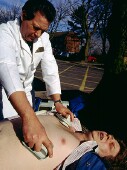
TUESDAY, Jan. 25 (HealthDay News) — Following a series of recalls of external defibrillators, a U.S. Food and Drug Administration panel of experts recommended Tuesday that the devices be held to stricter standards.
Over the past five years, there have been 68 recalls of automated external defibrillators, which are used to shock a patient in cardiac arrest in hopes of getting the heart to beat normally again, and are considered by many to be the quickest and best response to such an emergency.
In addition to the recalls, the FDA has also received 23,591 reports of device malfunctions, “including some where the device failure occurred during a rescue attempt and may have contributed to patient harm or death,” the agency noted in an executive summary released before the meeting of its Circulatory System Devices panel.
No official vote was taken by the panel, according to The New York Times, but most panel members said they felt the defibrillators should be placed in a high-risk category.
Dr. John W. Hirshfeld Jr., chairman of the advisory panel and a professor of cardiovascular medicine at the University of Pennsylvania, noted that “there are a number of signals that raise questions about quality and reliability,” the Times reported.
When external defibrillators were first brought before the FDA, they went through an accelerated approval program designed for low-risk devices that included such products as hospital beds and artificial hips. This so-called 510(k) system allows fast approval of devices that are similar to products already sold. Defibrillator manufacturers — including Cardiac Science Corp., Defibtech, Philips Medical Systems, Zoll Medical Corp., and others — have asked the FDA to keep their devices in this category, the Associated Press reported.
However, the agency said it was asking the advisory panel to recommend stricter standards because manufacturers did not fix the problems that led to the recalls, the AP reported.
The FDA wants the manufacturers to undergo regular inspections and provide additional clinical data for any new version of an external defibrillator, a procedure already in place for implantable defibrillators, the AP said.
The manufacturers would have a year to 18 months to do so, according to Dr. Bram D. Zuckerman, director of the division of cardiovascular devices in the FDA’s Office of Device Evaluation, the Times reported.
External defibrillators are computerized medical devices that can check a person’s heart rhythm and recognize a rhythm that requires a shock. They can also tell a rescuer when a shock is needed by using voice prompts, lights and text messages, according to the American Heart Association.
Each year, approximately 300,000 Americans suffer a cardiac arrest, according to the FDA. External defibrillators used by bystanders seem to save an estimated 474 lives a year, according to the FDA executive summary, and the devices are associated with almost doubling the survival of out-of-hospital cardiac arrest cases.
While the FDA is not bound to follow the recommendations of its advisory panels, it typically does so.
More information
For more on cardiac arrest, visit the U.S. National Library of Medicine.

